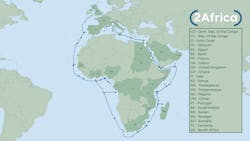2Africa submarine cable to connect 23 countries in Europe, Africa, Middle East
A consortium of China Mobile International, Facebook, MTN GlobalConnect, Orange, Saudi Arabia’s stc, Telecom Egypt, Vodafone, and WIOCC have unveiled plans to construct the 2Africa submarine cable. The undersea cable network will connect 23 countries in Europe, Africa, and the Middle East. Alcatel Submarine Networks has won a contract to deploy the submarine cable.
The 37,000-km submarine cable network will run eastward to Europe via Egypt (extending as far north as the UK), include connections in Saudi Arabia, and land at 21 points in 16 African countries (see map above). The initiative includes an agreement among the 2Africa parties, Airtel, and consortium member Telecom Egypt to build a new crossing that will link the Red Sea and the Mediterranean, the first such link in more than 10 years, according to the 2Africa parties. This project includes new cable landing stations and deployment of fiber across two new, diverse terrestrial routes parallel to the Suez Canal from Ras Ghareb to Port Said, as well as a new submarine connection that will provide a third path between Ras Ghareb and Suez.
The submarine cable will have a design capacity of up to 180 Tbps via space-division multiplexing (SDM) technology applied across as many as 16 fiber pairs. That capacity figure is greater than the combined capacities of all current African subsea systems, asserts the consortium. The network will leverage optical switching technology to enable flexible bandwidth management. The cable burial depth will be 50% greater than what the parties termed “older systems.” The cable route will avoid locations of known subsea disturbances; access to system capacity will come via carrier-neutral data centers or open-access cable landing stations. The submarine cable is expected to become operational in 2023/4.
“We’re excited to be collaborating with our 2Africa partners on the most comprehensive subsea cable that will serve the continent,” said Najam Ahmad, vice president, network infrastructure at Facebook. “2Africa is a major element of our ongoing investment in Africa to bring more people online to a faster internet. We’ve seen first-hand the positive impact that increased connectivity has on communities, from education to healthcare. We know that economies flourish when there is widely accessible internet for businesses. 2Africa is a key pillar supporting this tremendous internet expansion as part of Africa’s surging digital economy.”
For related articles, visit the Network Design Topic Center.
For more information on high-speed transmission systems and suppliers, visit the Lightwave Buyer’s Guide.
To stay abreast of fiber network deployments, subscribe to Lightwave’s Service Providers and Datacom/Data Center newsletters.
About the Author

Stephen Hardy
Editorial Director and Associate Publisher, Lightwave
Stephen Hardy is editorial director and associate publisher of Lightwave and Broadband Technology Report, part of the Lighting & Technology Group at Endeavor Business Media. Stephen is responsible for establishing and executing editorial strategy across the both brands’ websites, email newsletters, events, and other information products. He has covered the fiber-optics space for more than 20 years, and communications and technology for more than 35 years. During his tenure, Lightwave has received awards from Folio: and the American Society of Business Press Editors (ASBPE) for editorial excellence. Prior to joining Lightwave in 1997, Stephen worked for Telecommunications magazine and the Journal of Electronic Defense.
Stephen has moderated panels at numerous events, including the Optica Executive Forum, ECOC, and SCTE Cable-Tec Expo. He also is program director for the Lightwave Innovation Reviews and the Diamond Technology Reviews.
He has written numerous articles in all aspects of optical communications and fiber-optic networks, including fiber to the home (FTTH), PON, optical components, DWDM, fiber cables, packet optical transport, optical transceivers, lasers, fiber optic testing, and more.
You can connect with Stephen on LinkedIn as well as Twitter.
